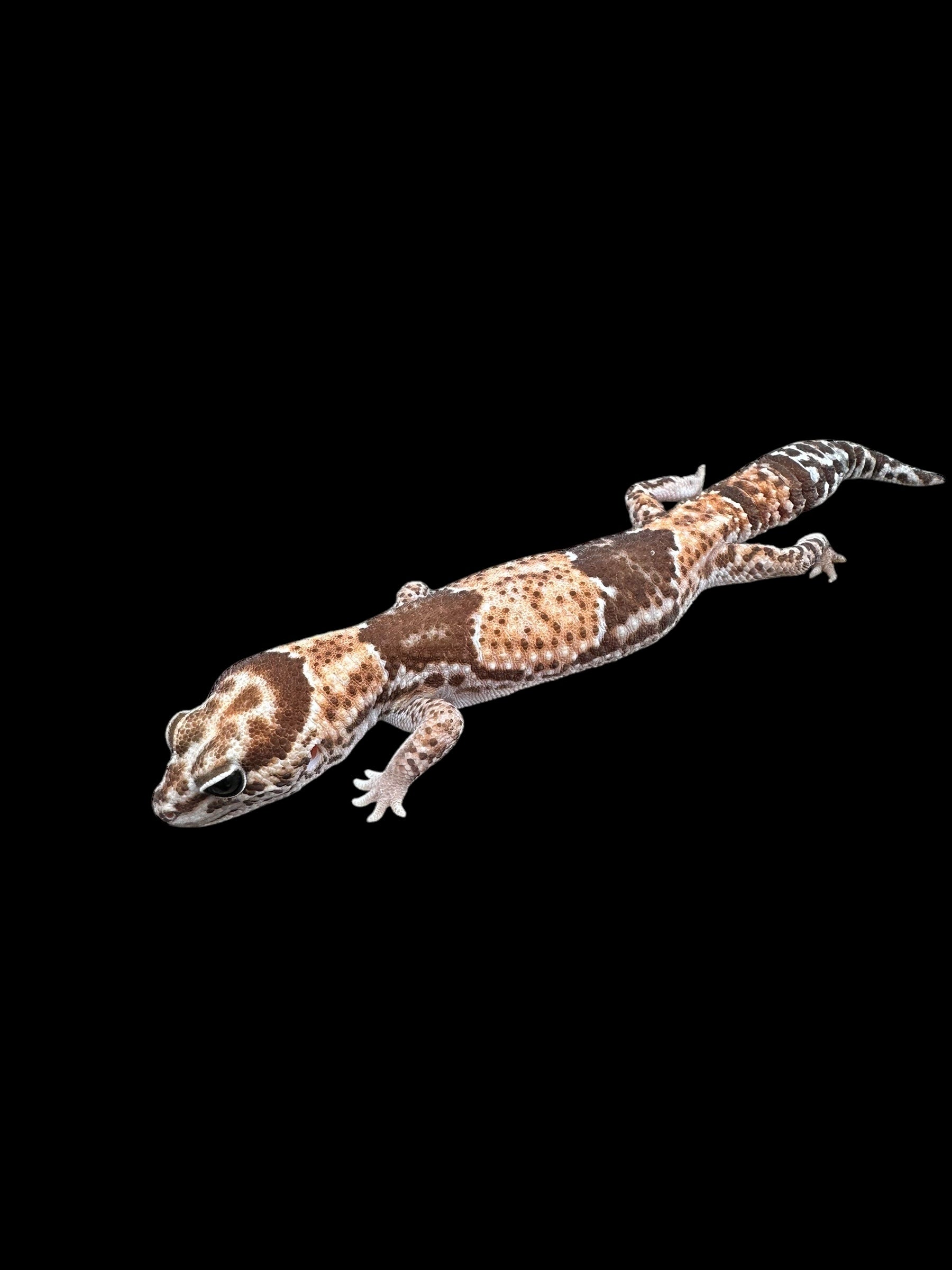Photo Disclaimer
Description
African Fat Tail Gecko (het. Caramel Oreo Patternless)
Scientific Name: Hemitheconyx caudicinctus
Common Name: African Fat Tail Gecko
Species Overview
Size: Adult African Fat Tail Geckos typically reach 7–8 inches (18–20 cm) in length, with males being slightly larger and more heavily built. Their thick tails serve as energy reserves, helping regulate hydration and overall condition.
Appearance: The het. Caramel Oreo Patternless African Fat Tail Gecko displays the natural brown and beige banding typical of the species, as the carried genes are not visually expressed. However, this combination makes for an exceptional breeder with high genetic potential. When expressed, the Caramel gene lightens overall coloration to warm golden tones, the Oreo gene deepens pigmentation to near-black contrast, and the Patternless gene removes markings entirely, creating clean, smooth colouration. Together, these genes can produce a wide range of visually stunning offspring, from dark chocolate tones to soft golden solids, depending on pairings.
Distribution: Native to West Africa, including Senegal, Ghana, Togo, Benin, and Nigeria, where they inhabit semi-arid savannas, rocky plains, and grasslands.
Habitat: In their natural environment, African Fat Tail Geckos live in dry regions, hiding in burrows or beneath rocks to avoid extreme heat. In captivity, they thrive in naturalistic terrariums that mirror these conditions, using compact soil-sand substrates, stable humidity, and multiple hiding areas for security.
Behaviour: These geckos are calm, nocturnal, and adaptable. They move slowly and are tolerant of handling once acclimated, making them well-suited for both breeding and display.
Captive Care
Enclosure: Provide an enclosure of at least 24 inches × 18 inches × 12 inches (60 × 45 × 30 cm) for a single adult. Naturalistic setups with a compact soil-sand-clay mixture allow for digging and moisture regulation. For juveniles or temporary housing, reptile carpet, tile, or paper towel can be used for ease of cleaning and safety. Include three hides—one warm, one cool, and one humid—to ensure proper thermoregulation and shedding.
Temperature & Humidity: Maintain a warm-side surface temperature of 88–92°F (31–33°C) and a cool side around 75–80°F (24–27°C). Nighttime temperatures can drop safely to 70–74°F (21–23°C). Keep humidity between 50–70%, with a slightly damp hide available to aid shedding.
Lighting: Although UVB lighting is optional, a low-level UVB source (2–5%) supports natural behaviour and vitamin D metabolism. Maintain a 12-hour day/night light cycle.
Diet: Feed a rotating diet of gut-loaded crickets, dubia roaches, mealworms, and silkworms. Supplement insects regularly with calcium and multivitamin powders. Juveniles should be fed daily, while adults can be fed every 2–3 days.
Behaviour in Captivity: African Fat Tail Geckos are docile and predictable, showing consistent feeding habits and tolerance of gentle handling. With stable care, they thrive and readily adapt to captivity.
Special Considerations: Always regulate heat sources with a thermostat to prevent burns. Monitor tail thickness as a key indicator of proper nutrition and overall health.
Sand: Addressing Concerns and Misconceptions
Sand has been widely debated due to impaction concerns. When used as part of a compact soil-sand mix and paired with proper heat, hydration, and husbandry, the risk is minimal. Issues generally arise with loose or calcium-based sands used under poor maintenance. For hatchlings, juveniles, or newly acquired geckos, reptile carpet, tile, or paper towel are safer until fully established.
Taxonomy Note
The African Fat Tail Gecko (Hemitheconyx caudicinctus) belongs to the family Eublepharidae, which includes other eyelid geckos such as the Leopard Gecko (Eublepharis macularius). Unlike adhesive-toed geckos, this family retains movable eyelids and lacks toe pads, making them entirely terrestrial. The species shows stable characteristics across its range, with mild natural variation.
Genetics Note
het. Caramel (Recessive Carrier): Carries one copy of the Caramel gene, which reduces melanin and softens coloration into warm golden and light brown hues when expressed.
het. Oreo (Recessive Carrier): Carries one copy of the Oreo gene, which increases melanin, resulting in rich dark pigmentation and striking contrast when expressed.
het. Patternless (Recessive Carrier): Carries one copy of the Patternless gene, which removes or heavily reduces markings, creating a clean, uniform body tone when expressed.
(“het.” is short for heterozygous, meaning one copy of a gene is carried but not visually expressed.)


